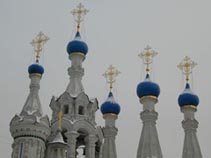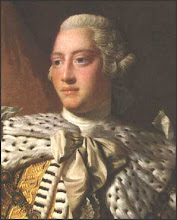Saturday, July 19, 2008
Requiem for the Romanovs
MOSCOW, Russia, July 16, 2008 -- A single tear. It welled up, then fell from the corner of one of the principal soloist's eyes, glistening as it ran down her cheek.
She was a young Russian woman, dressed in a white gown, and she was performing here tonight at the world premiere of a "Requiem Concert" in Russia's largest church, Christ the Savior, in a commemoration of the 90th anniversary of the execution of the last Russian Czar and his family -- Nicholas II, his wife Alexandra, their four daughters Olga, Tatyana, Maria, and Anastasia, and their son, Alexei -- on the night of July 17, 1918.
In her weeping, the soloist was not alone. Many of the more than 2,000 people who filled into the concert hall of the largest basilica in Russia, the Church of Christ the Savior, bombed by Stalin and rebuilt in the 1990s, wept openly as they listened and watched the tragedy of the last Romanovs unfold.
Outside, a summer rain fell.
...For almost two hours this evening, a Russian orchestra and choir alternated with historical and scriptural readings, accompanied by a skillfully done video documentary containing never-before-seen footage from the time of the Russian Revolution, to meditate on the Romanovs, and on the communist persecution of religion in Russia which followed for 73 years (1918-1991).
The historical texts and music were by the Russian Orthodox Bishop Hilarion Alfeyev, bishop of Vienna, Austria, for the Russian Orthodox in central Europe. Alfeyev also participated in the performance, reading Scriptural passages in which the sufferings of Christ seemed to foreshadow the sufferings of his followers in communist Russia.
The Russian voices soared majestically, filling the hall. The images projected on the screen showed the last days of the Romanovs -- and moved the soloist to shed a tear...
The Vatican's current representative in Russia, Papal Nuncio Antonio Mennini, an affable career Church diplomat who has labored for the past two years in Moscow to build a relationship of trust between Rome and the Russian Orthodox, was present in the front row throughout the performance. Also present were a number of Russian political leaders, but not the counrty's highest leadership.
I sat next to Mennini, and when the final crescendo, a cry of faith transcending all suffering and death entitled "Come, let us worship," concluded, in the quiet instant before the crowd erupted with applause, Mennini, who had seemed hesitant about the whole affair at the outset of the performance, turned slightly toward me and spoke a single word: "Bella!" ("Beautiful!")
...But it was more than that.
It was a cultural and socio-political watershed for the Russian Orthodox Church in post-communist Russia, stating the case more forcefully and persuasively than ever before that Russia needs to acknowledge, and repent, of the crimes of her communist past in order to build a new, post-Soviet Russia.
...It is not focused on the last Czar alone, and on his family, though the anniversary of their deaths provided the occasion for the Requiem.
Rather, the performance continues after the deaths of Nicholas and Alexandra and their children, right through the 1920s and 1930s, examining the tragic consequences for religious faith in Russia of the victory of the communists: the hundreds and thousands of Orthodox priest, nuns and laypeople imprisoned and executed -- and the many Catholics also arrested and killed. (This was mentioned in the performance.)
Thus, this performance transcends Russia's royal family, and takes up in a compelling way the "great question" of Russia's choice and destiny and suffering during the 20th century.
In this sense, the Requiem is far from a "nostalgic recollection" of the "good old days of the czars."
Instead, it is a searing socio-political critique of the atheism and persecution of religious belief central to Russia's communist regime.
In this performance, therefore, the Russian Orthodox Church sets forth a powerful, emotionally compelling case for public recognition in Russia of the crimes of the Soviet period (the performance was blessed by Russian Orthodox Patriarch Alexi II, although he did not personally attend, reportedly because of meetings with the Greek Orthodox Patriarch of Cyprus, who is visiting Moscow in these days)..
-Robert Moynihan: From an article in Inside the Vatican magazine. I strongly recommend the article in its entirety.
Subscribe to:
Post Comments (Atom)









No comments:
Post a Comment